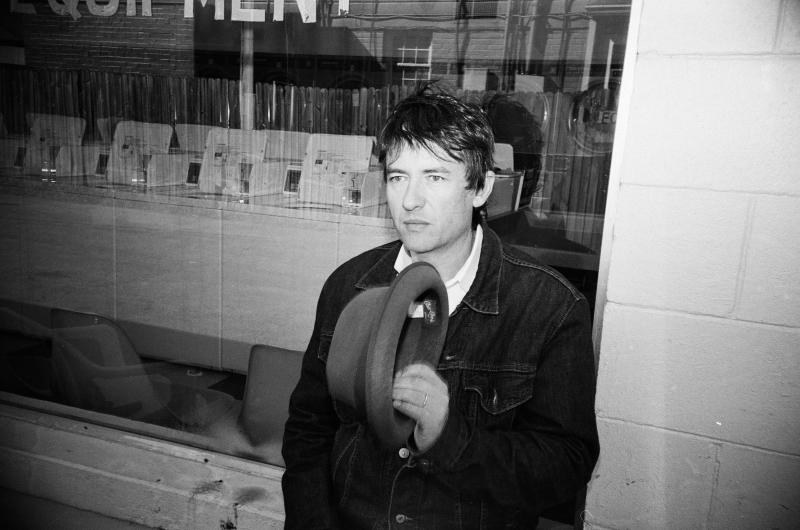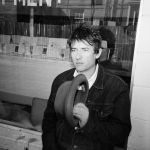
By Jim Hynes
“Jimmie [Rodgers] was determined to be an entertainer,” Burch recounted to me, when I chatted with him about his soon to be released album, Meridian Rising. “He worked with so many other people, and incorporated so many styles into his music when there was no central star to emulate. I wanted to write about his life from a musician and the entertainer perspective.” The stories Burch weaves on his latest effort stem from the considerable research that he did through the work of Rodgers’s biographers, the Country Music Hall of Fame and the C.F. Martin Guitar archives. He describes the process as “episodic,” as he drew stories from multiple sources to create his imagined autobiography of a long dead legend. For example, he recalls one amusing anecdote, “Rodgers sent a letter to C.F. Martin hand-written in pencil, essentially trying to get a discount on a guitar before he even had a record out. He just knew the right moves. When he went to Hollywood, he had lunch with Laurel and Hardy, the major comedians of his time. He felt like he just naturally was born to be an entertainer. I can easily see him getting into some of the scrapes revealed in these stories.”
Although it’s still early in 2016, there’s already a sense that Meridian Rising could be one of the best and most important albums of the year. It’s the combination of two factors: the stories that define the colorful nature of Rodgers’s short but remarkably influential career, and the spirited music from Burch’s WPA Ball Club, which features Fats Kaplin, Jen Gunderman, Dennis Crouch and Tommy Perkinson, and may well be the best band in Nashville. To top it off, they are augmented by stellar guests like Jon Langford, Tim O’Brien, Billy Bragg, William Tyler and Gary Tallent (playing a tuba no less). One of the truly identifying and lasting sounds from this album is the lyrical clarinet form Chloe Feoranzo. Burch says, “I met [Feoranzo] when we opened for Pokey LaFarge’s band, where she was playing saxophone and clarinet. She’s not from Nashville. She’s from California, so I thought she could bring in a different perspective. The clarinet defines the twenties and has kind of a story telling sound to it.” Her clarinet notes are the first sounds you hear in the opening track, “Meridian” (Rodgers’s home town), and she colors many of the others with her fluid lines.
When I asked Burch how his band and the accompanying musicians responded to his ambitious concept, he told me, “It was actually easy to do, even though it was a great challenge in a sense. I wanted the music to be fun, so even if the listener wasn’t into the story concepts, they’d like the music. It was relief to the band, because none of the music had anything to do with rock n’ roll. In most sessions when you hit a snag, you go back to certain records as reference points. We didn’t feel the pressure of going back in time. I was after the atmosphere, and it felt like we were doing something new. Hey, we didn’t know if we were right or wrong. Not using any electric instruments gave us a sense of freedom too. I do play an electric guitar on “Cadillacin” but it is played through a period style microphone. I was after the atmosphere of it, not trying to replicate anything. We actually did many of the tracks in just one or two takes.”
Beginning in Rodgers’s exceptionally affluent home town of Meridian, MS, Rodgers goes “Cadillacin”, a term he used for his solo gigs. The tune features an irresistible rhythmic groove, punctuated by Jen Gunderman’s piano and Feoranzo’s sax. “U.S Rte 49” is famous for its tuberculosis sanatorium. Rodgers’ eventually succumbed to that disease, but died in New York, thereby avoiding this nightmarish place. “Black Lady Blues” explores Rodgers’ fondness for late night poker games, while “Gunter Hotel Blues” describes where Jimmie stayed in San Antonio, the same hotel where Robert Johnson later recorded. “Under the Canvas” and “The Girl Sawed in Half” depict tent show carnivals to Fats Kaplin Hawaiian guitar picking. “If I Could Only Catch My Breath” is about Jimmie trying to get a gig in England, and features narration from Jon Langford on the CD and Billy Bragg on the vinyl version. Rodgers recorded on his death bed just two days before his passing, and fittingly, the closing tracks of “Fast Fuse Blues” and “Back to the Honky Tonks” focus on that indomitable spirit rather than the passing itself. I’ll leave it to your listening enjoyment and Burch’s generous liner notes to color in the rest of Rodgers’ story.
Burch says he had the idea to do an album on Rodgers back in 2000, but really sparked to the idea when listening to “Let Me Be Your Sidetrack,” which Jimmie recorded with blues guitarist Clifford Gibson. Burch explains, “Gibson was such an accomplished guitarist. He played in open tuning, similar phrasing to Robert Johnson. It was such a different style for Rodgers, yet his voice fit over it perfectly. You would think you’re hearing one singular singer/guitarist. Rodgers’ timing wasn’t always right, but his feeling was always spot on. Thinking about it, it wasn’t really an anomaly, because Rodgers played with the Mississippi Sheiks, Howlin’ Wolf and Louis Armstrong. I think this was because Rodgers was always trying to come up with new material. He often arrived at the recording studio a little short-handed. Rodgers’ instincts as a musician were so far ahead of his time. He saw the future before there was one. He understood that to be entertainer, you have to entertain everybody. It is just remarkable that he could forge his style with so many other influences, whether it was a Hawaiian guitar player, minstrel shows, or Silas Greene’s New Orleans tent shows. He had to pick up his stuff from lots of places.”
Assuming this wonderful project piques your interest in Jimmie Rodgers– and it will– here are some other sources you may want to investigate while listening to Burch’s story-laden tunes. They are: Jimmie Rodgers – The Life and Times of America’s Blue Yodeler by Nolan Porterfield, Meeting Jimmie Rodgers: How America’s Original Roots Music Hero Changed the Pop Sounds of a Century by Barry Mazor, insights into Rodgers’ producer Ralph Peer also by Barry Mazor, entitled Ralph Peer – And the Making of Popular Roots Music, and a collection of sketches from artists influenced by Rodgers, called Waiting on a Train- Jimmie Rodgers’s America edited by Mary E. Davis and Warren Zanes.





Be the first to comment!